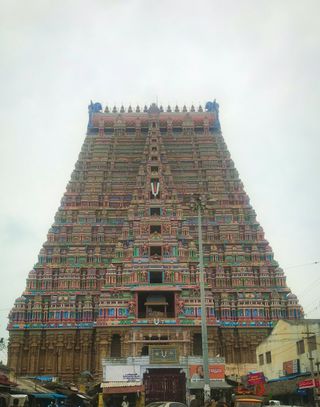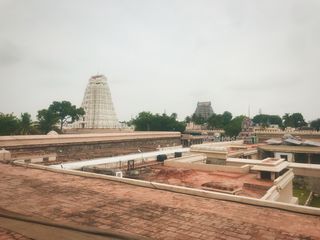Sri Ranganathaswamy Temple

| Deity | Ranganathar (Vishnu) |
| State | Tamil Nadu |
| Creator(s) | Cholas, Pandyas, Vijayanagara Empire |
| Location | Srirangam |
Introduction
The Sri Ranganathaswamy Temple at Srirangam is ranked foremost among the 108 Vaishnava temples (Divya desams) in India. Located in an isle formed by the twin rivers Cauvery and Coleroon, it almost borders the temple city of Tiruchirapalli.
Spread over 155 acres, the temple contains seven prakaras or enclosures, representing the seven chakras of our body. Inside the compound area stand 81 shrines, 21 gopurams and 39 grand pavilions. Built in stone with elaborate carvings, the complex has over 800 inscriptions that offer insights into religious and social influences during the medieval era.[ref]
The Srirangam temple’s significance is tied to the Vaishnava movement that spread rapidly in the turn of the second millennium. The earliest Vaishnava saints (Poigai, Pudam, Pey) practiced a very simple form of devotion, and over centuries the creed of Vishnu worship began gaining in prestige. The likes of Tirumailisai and Tirumangai wrote poems that convulsed people towards this movement. These practitioners began being called Alvars, the most famous among them being Andal. By the time the Cholas gained supremacy in South India, the Vaishnava cult had become a dominant force that shaped the lives of people in the region.
History
Legend of origin
The Sriranga Mahatmya is a sthala-purana that informs us about the origins of the temple. It claims that the vimana for the temple sprung up from the oceans owing to the penance of Lord Brahma. Ikshvaku brought this vimana to Ayodhya, and his descendent Lord Rama gifted it to Vibhishana upon the latter’s coronation in Lanka. En route to Lanka, he reached the banks of Cauvery, and placed the vimana on the ground. To everyone’s surprise, it remained fixed to the ground, leaving Vibhishana distraught and perplexed. Dharmendra Chola consoled him and assured him that the temple will soon attract a lot of worshippers. Thus, Srirangam was blessed with a glorious temple. This is simply a folk account, and scholars have ruled out any possibility of its historicity.
Koil Olugu
A more detailed yet historically tenuous account is offered by the Koil Olugu. This source attributes the origin of the shrine to a certain Kili Chola, who supposedly resuscitated the temple after it was buried in a sandstorm. However, as will be evident later in this article, it does carry fragments of historical truth as it vividly characterises the brutality of the Islamic invasions.
The founder of this temple is widely deemed to be the selfsame Kili Chola, who may have ruled during the Sangam age (1st-3rd century CE). The earliest inscriptions in the temple, though, are evident only from the 10th century onwards, with the Chola kings being strong patrons. The first Chola inscription in the shrine is dated to the seventeenth regnal year of Parantaka I. Rajamahendra Chola, grandson of Rajendra Chola, is attributed with building the second prakara wall and an enclosure called Rajamahendra Tiruvadi.
Ramanujacharya
Ramanuja is considered to be a legendary philosopher, formulating the doctrine of Vishistha Advaita. He succeeded his guru Yamucharya as the head of the matha at Srirangam, giving him a position of authority in the Vaishnava sect. His influence grew massively in this phase, as he stoutly refuted Sankara’s theory of Advaita. Thus, using Srirangam as his headquarters, Ramanuja propagated his philosophical doctrines with great fervour. This of course, before, he was allegedly expelled by the Chola emperor Kulottunga I.
Contributions of Hoysalas and Pandyas
The Hoysalas of Dwarasamudra, who emerged as a powerful dynasty in the 12th century AD, also made vital architectural contributions to the Srirangam temple. Two generals- Kampaya Dandanayaka and Kariyamanikka Dandanayakka- are attributed with constructing important structures, shrines and mantapas. In addition, the Venugopa shrine in the fourth Prakara of the temple is also attributed to the Hoysalas.
It is however, under the Pandyas, that the Srirangam temple seemingly reached its zenith in terms of cultural activity. Jatavarman Sundara Pandyan was a great benefactor of the temple, covering it with gold and bestowing numerous gifts. The Koil Olugu estimates the total value of his gifts to be a staggering 18,000 gold pieces.[ref] [ref]
Islamic Invasions
Malik Kafur's raid in 1311
The Islamic invasions though marked a complete reversal of fortune for a temple that had by the end of the 13th century become the hub of cultural and festive activity. Malik Kafur, sultan Alauddin Khilji’s general, spearheaded a raid on the Tamil country (Ma’bar) in 1311, but the forces from Delhi were kept at bay by a resilient Pandyan army. Nonetheless, considerable damage was inflicted on the Srirangam temple, as can be inferred from accounts of Amir Khusrau as well as the Koil Olugu. Khusrau refers to the sacking of a golden temple at Marhatpuri, leading to immense bloodshed. The Alagiyamanavalan image was carried away by the invading forces.
The Koil Olugu narrates a fascinating story of a woman devotee named Pinchenravalli who followed the Sultanate army in the guise of a mendicant. The image landed on the laps of a princess named Sultani, and this incensed Pinchenravalli. She entertained the Sultan with songs, demanding the Perumal in return. Stunningly, upon its name being taken, the Perumal appeared and the Sultan granted her permission to take it back. This grieved Sultani, and an army was sent to retrieve the image. The army returned without fruit, and Sultani died of grief. [ref]
The story has been established as a flight of fancy, but its composition does highlight an attempt to cling on to faith in times of strife. It is assumed that the first invasion by Kafur didn’t halt worship, as the images were replaced and devotees continued flocking to the temple.
Ulugh Khan's invasion in 1323
The second invasion in 1323, under Ulugh Khan, was far more destructive, as the northern face of the Nammalvar shrine was reduced to rubble, and the Ranganatha image was nearly damaged. However, texts highlight the efforts taken by devotees to protect the image. Pillai Lokacharya along with a group of parijanas had been intimated about the impending invasion, and sent the image in a southern direction. The assistance of celebrated Vaishnava acharya Vedanta Desika proved invaluable, especially in sending a second set of treasure and jewels to follow the first one. All this happened prior to the desecration of the temple, that remained under Muslim occupation for nearly fifty years.
The Koil Olugu provides a rich account of the image criss-crossing almost the whole of South India. It was housed in a number of locations including Gostipura, Jyostikudi and Alagarkoil (twelve miles north of Madurai). Its peripatetic existence finally culminated in it being housed in the Srivenkateshwara temple in Tirupati.[ref]
Revival Of The Temple

In 1336, Harihara and Bukka founded the Vijaynagar Empire. The Alagiyamanavalam image was shifted from Tirupati to Singapuram, where it continued being worshipped. The temple, though remained occupied until 1371. In the 1340s, the Madurai Sultanate came into existence, and Tondai-mandalam remained in a precarious position. The Madura-Vijayam of Gangadevi, which records the triumphant march of Kumara Kampana, also underlines the pitiable condition of the Sriranganathaswamy temple. After Kampana ousted the Sultans from Madurai, worship resumed in the temple after nearly half a century of strife. The Alagiyamanavalam image was duly reinstated in its original abode.
The Vijayanagara emperors helped revive the temple, and were helped in no small measure by the donations given during festivals. By 1490, the Srirangam temple owned as many as 1490 villages, signifying its having risen to prominence once again.
The Nayakas of Tanjore and Madurai too were patrons of the temple, and helped lay out streets and conduct mandapas too. In the 18th century, the temple was converted into a fortress during the decades’ long Carnatic Wars between the British and the French. However, worship went on as usual. Later, Haidar Ali and Tipu Sultan too occupied the temple in 1781 and 1790 respectively, though no significant damage has been recorded.
Finally, in 1801, John Wallace assumed charge of the Srirangam temple. In 1841, it was handed over to a body of four stallatar (trustees).
